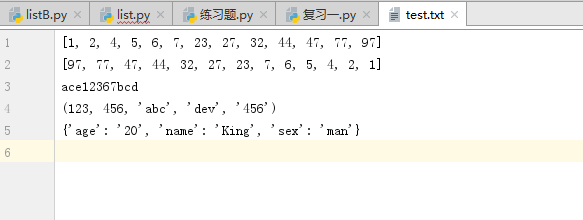复习上周的内容
说明:根据投票,多数同学建议复习一下。所以给两天时间,同学们抓紧时间好好消化。
实现如下:
1. 把一个数字的list从小到大排序,然后写入文件,然后从文件中读取出来文件内容,然后反序,在追加到文件的下一行中
2. 分别把 string, list, tuple, dict写入到文件中

1 #! /usr/bin/env python 2 # _*_ coding:utf-8 _*_ 3 # @Time :2017/10/30 17:45 4 # @Author :Kelake 5 # @FileName :复习一.py 6 7 # 三周一次课(10月30日)三周二次课(10月31日) 8 # 复习上周的内容 9 # 说明:根据投票,多数同学建议复习一下。所以给两天时间,同学们抓紧时间好好消化。 10 # 实现如下: 11 # 1. 把一个数字的list从小到大排序,然后写入文件,然后从文件中读取出来文件内容,然后反序,在追加到文件的下一行中 12 # 2. 分别把 string, list, tuple, dict写入到文件中 13 14 L1 = [1,2,5,7,23,47,77,97,6,4,44,32,27] 15 S1 = "ace12367bcd" 16 T1 = (123,456,"abc","dev","456") 17 D1 = {"name":"King" , "sex":"man" , "age":"30"} 18 print "Display list L1:" , L1 19 print "Display str S1:" , S1 20 print "Display tuple T1:" , T1 21 print "Display dict D1:" , D1 22 23 #小到大排序 24 L1.sort() 25 print "列表L1从小到大的排序是:",L1 26 L1.sort() 27 L2 = str(L1) 28 print type(L2) 29 print L2 30 print "将L1列表从小排到大写入文件test.txt中" 31 import codecs 32 L3 = codecs.open("test.txt" , "w") 33 L3.write(L2 + " ") 34 L3.close() 35 print "读取test.txt里面的内容,并将里面的内容转换成列表,并从大到小排序。" 36 L4 = codecs.open("test.txt" , "r") 37 L5 = L4.read() 38 L4.close() 39 print L5 40 print type(L5) 41 L6 = eval(L5) 42 print L6 43 print type(L6) 44 L6.reverse() 45 print L6 46 L7 = str(L6) 47 print "读取test.txt里面的内容,并将里面的内容转换成列表,并从大到小排序,然后追加到test.txt的文件中。" 48 L8 = codecs.open("test.txt" , "a+") 49 L8.write(L7 + " ") 50 L8.close() 51 print "将字符串追加到test.txt的文件中。" 52 53 S2 = codecs.open("test.txt" , "a+") 54 S2.write(S1 + " ") 55 S2.close() 56 57 print "将元组追加到test.txt的文件中。" 58 T2 = str(T1) 59 T3 = codecs.open("test.txt" , "a+") 60 T3.write(T2 + " ") 61 T3.close() 62 63 print "将字典追加到test.txt的文件中。" 64 D2 = str(D1) 65 D3 = codecs.open("test.txt" , "a+") 66 D3.write(D2 + " ") 67 D3.close() 68 69 L9 = list(D1) 70 print type(L9) 71 print L9 72 print dict.values(D1) 73 print dict.keys(D1)
运行截图:

生成的test.txt文件截图:

